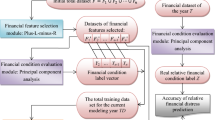Abstract
Financial distress prediction models are much challenged in identifying a distressed company two or more years prior to the occurrence of its actual distress, on the grounds that the distress signal is too weak to be captured at an early stage. The paper innovatively proposes to predict the distressed companies by a factorial discriminant model based on interval data. The main idea is that we use a new data representation, i.e., interval data, to summarize four-quarter financial data, and then build a interval-data-based discriminant model, namely i-score model. Interval data makes both average and volatility information comprehensively included in the proposed prediction model, which is expected to improve prediction performance on the distressed companies. A comparison based on a real data case from China’s stock market is conducted. The i-score model is compared with five commonly used models that are based on numerical data. The empirical study shows that i-score model is more accurate and more reliable in identification of companies in high risk of financial distress in advance of 2 years.



Similar content being viewed by others
References
Altman EI (1968) Financial ratios, discriminant analysis and the prediction of corporate bankruptcy. J Finance 23(4):589–609
Altman EI, Haldeman RG, Narayanan P (1977) Zeta analysis: a new model to identify bankruptcy risk of corporations. J Bank Finance 1(1):29–54
Billard L, Diday E (2003) From the statistics of data to the statistics of knowledge: symbolic data analysis. J Am Stat Assoc 98(462):470–487
Bock H-H, Diday E (2000) Analysis of symbolic data: exploratory methods for extracting statistical information from complex data. Springer, Berlin
Campbell JY, Taksler GB (2003) Equity volatility and corporate bond yields. J Finance 58(6):2321–2350
Campbell JY, Hilscher J, Szilagyi J (2008) In search of distress risk. J Finance 63(6):2899–2939
Chen J, Chollete L, Ray R (2010) Financial distress and idiosyncratic volatility: an empirical investigation. J Financ Mark 13(2):249–267
Dichev ID, Tang VW (2009) Earnings volatility and earnings predictability. J Account Econ 47(1–2):160–181
Diday E, Noirhomme-Fraiture M (2008) Symbolic data analysis and the SODAS software. Wiley, Chichester
He LT, Hu C (2007) Impacts of interval measurement on studies of economic variability: evidence from stock market variability forecasting. J Risk Finance 8(5):489–507
Irpino A, Verde R (2008) Dynamic clustering of interval data using a wasserstein-based distance. Pattern Recognit Lett 29(11):1648–1658
Lauro N, Verde R, Palumbo F (2000) Factorial discriminant analysis on symbolic objects. In: Bock HH, Diday E (eds) Analysis of symbolic data, exploratory methods for extracting statistical information from complex data. Springer, Heidelberg, pp 212–333
Lee YC, Huang SY (2009) A new fuzzy concept approach for kano’s model. Exp Syst Appl 36(3):4479–4484
Li Q (2013) A novel likert scale based on fuzzy sets theory. Exp Syst Appl 40(40):1609–1618
Merton RC (1974) On the pricing of corporate debt: the risk structure of interest rates. J Finance 29(2):449–470
Meyer PA, Pifer HW (1970) Prediction of bank failures. J Finance 25(4):853–868
Minton B, Schrand C, Walther B (2002) The role of volatility in forecasting. Rev Account Stud 7(2):195–215
Moore RE (1966) Interval analysis. Prentice-Hall, Upper Saddle River
Silva APD, Brito P (2006) Linear discriminant analysis for interval data. Comput Stat 21:289–308
Silva APD, Brito P (2015) Discriminant analysis of interval data: an assessment of parametric and distance-based approaches. J Classif 32(3):516–541
Sun J, Li H (2008) Data mining method for listed companies’ financial distress prediction. Knowl Based Syst 21(1):1–5
Sunaga T (2009) Theory of interval algebra and its application to numerical analysis. Jpn J Ind Appl Math 26(2):125–143
Tsai C-F, Wu J-W (2008) Using neural network ensembles for bankruptcy prediction and credit scoring. Exp Syst Appl 34(4):2639–2649
Wang H, Guan R, Wu J (2012) Cipca: complete-information-based principal component analysis for interval-valued data. Neurocomputing 86:158–169
Xu X, Chen Y, Zheng H (2011) The comparison of enterprise bankruptcy forecasting method. J Appl Stat 38(2):301–308
Zavgren CV (1985) Assessing the vulnerability to failure of american industrial firms: a logistic analysis. J Bus Finance Account 12(1):19–45
Acknowledgements
The research of Rong Guan is supported by National Natural Science Foundation of China (Grant No. 71401192), the Fundamental Research Funds for the Central Universities (QL18009), and the Program for Innovation Research in Central University of Finance and Economics. The research of Huiwen Wang is supported by National Natural Science Foundation of China (Grant No. 71420107025). The research of Haitao Zheng is partially supported by National Natural Science Foundation of China (Grant Nos. 71371021, 71873012), and Humanities and Social Sciences Planning Fund of Ministry of Education (Grant No. 17YJA790097).
Author information
Authors and Affiliations
Corresponding author
Additional information
Publisher's Note
Springer Nature remains neutral with regard to jurisdictional claims in published maps and institutional affiliations.
Appendices
Appendix
Data and Figures
For reader’s convenience, we provide the stock ID information of the 147 selected company pairs in Table 7. Besides, descriptive figures of the samples of the interval-valued data and numerical data are respectively shown in Figs. 4 and 5. Each of the 21 subfigures corresponds to two of the seven financial ratios. In Fig. 5, distressed companies are shown as light brown crosses, whereas healthy companies are drawn as black circles. In Fig. 4, rectangles in light brown and black correspond to distressed and healthy companies, respectively.
Rights and permissions
About this article
Cite this article
Guan, R., Wang, H. & Zheng, H. Improving accuracy of financial distress prediction by considering volatility: an interval-data-based discriminant model. Comput Stat 35, 491–514 (2020). https://doi.org/10.1007/s00180-019-00916-9
Received:
Accepted:
Published:
Issue Date:
DOI: https://doi.org/10.1007/s00180-019-00916-9






